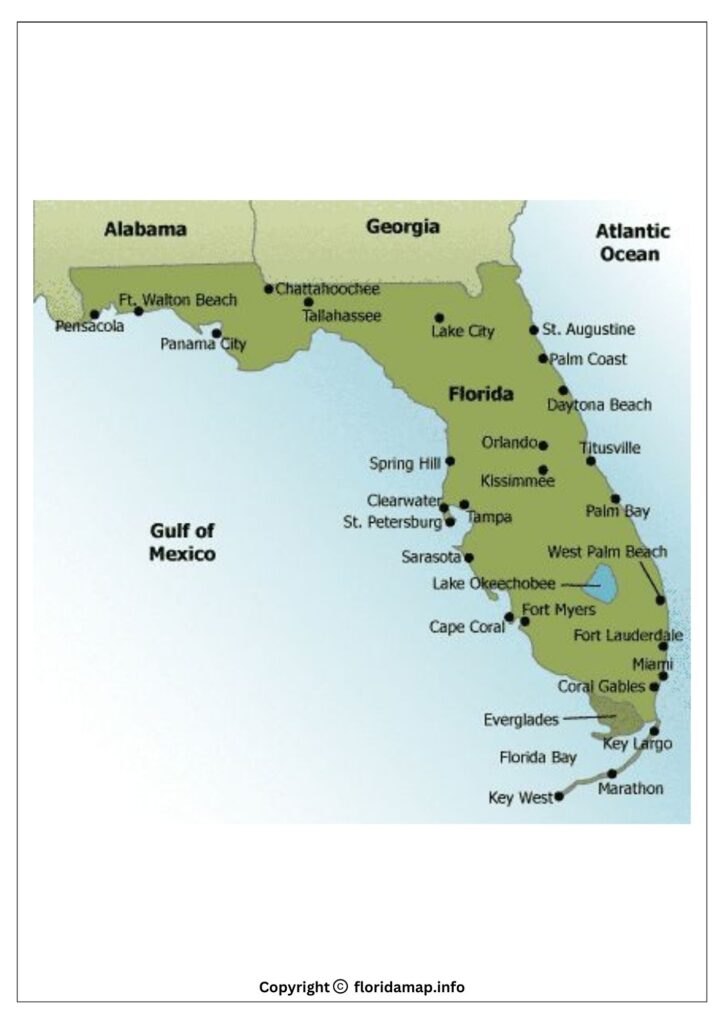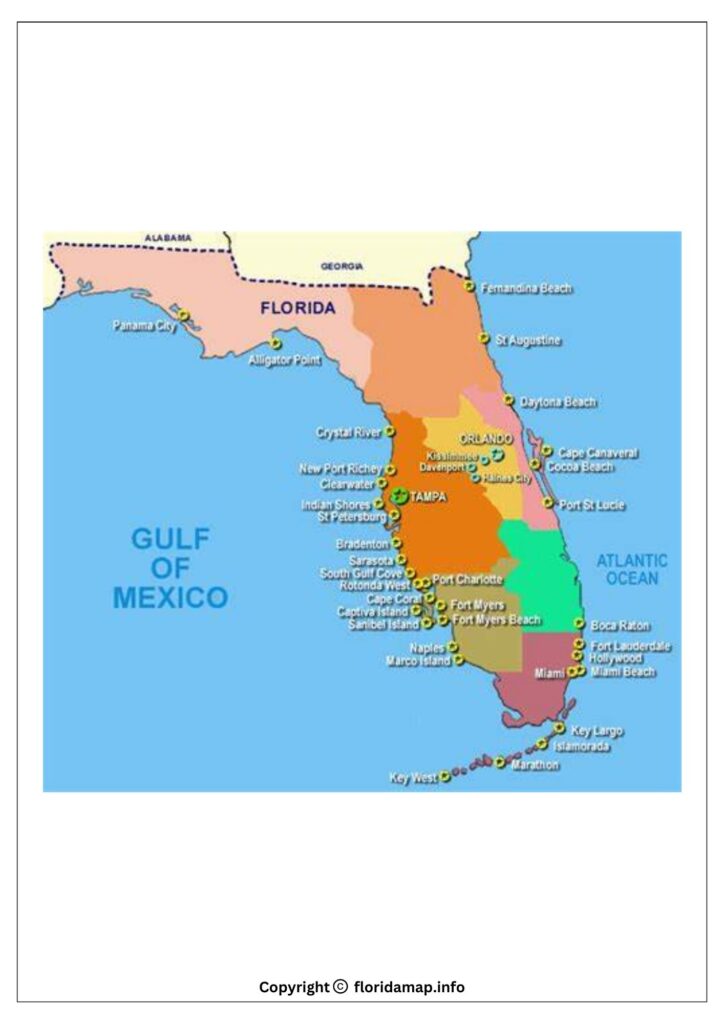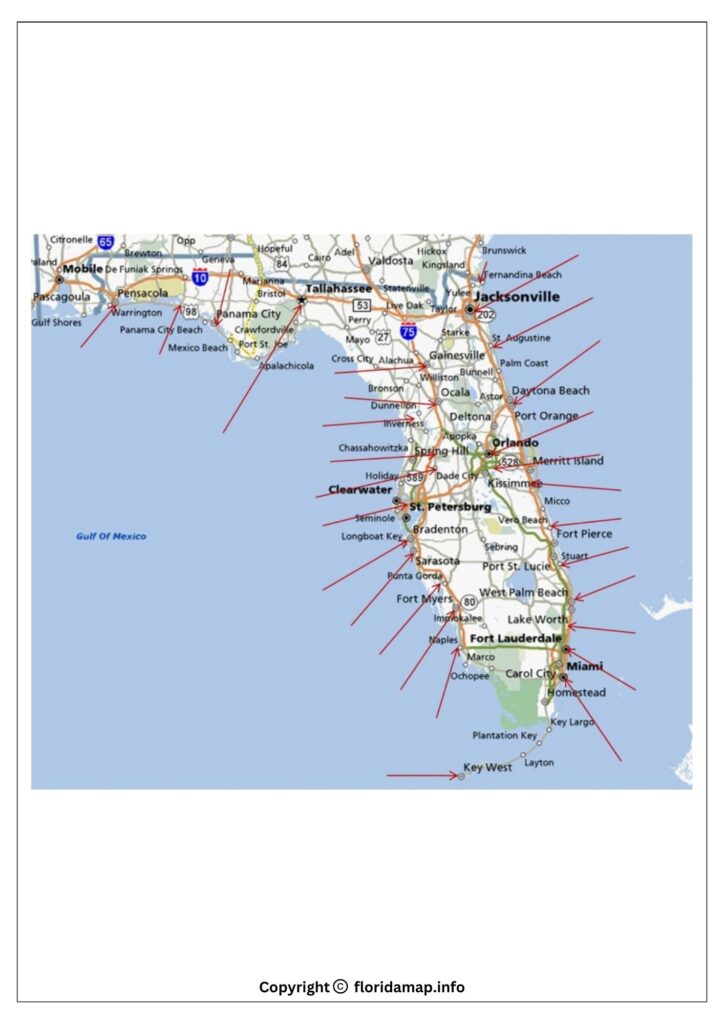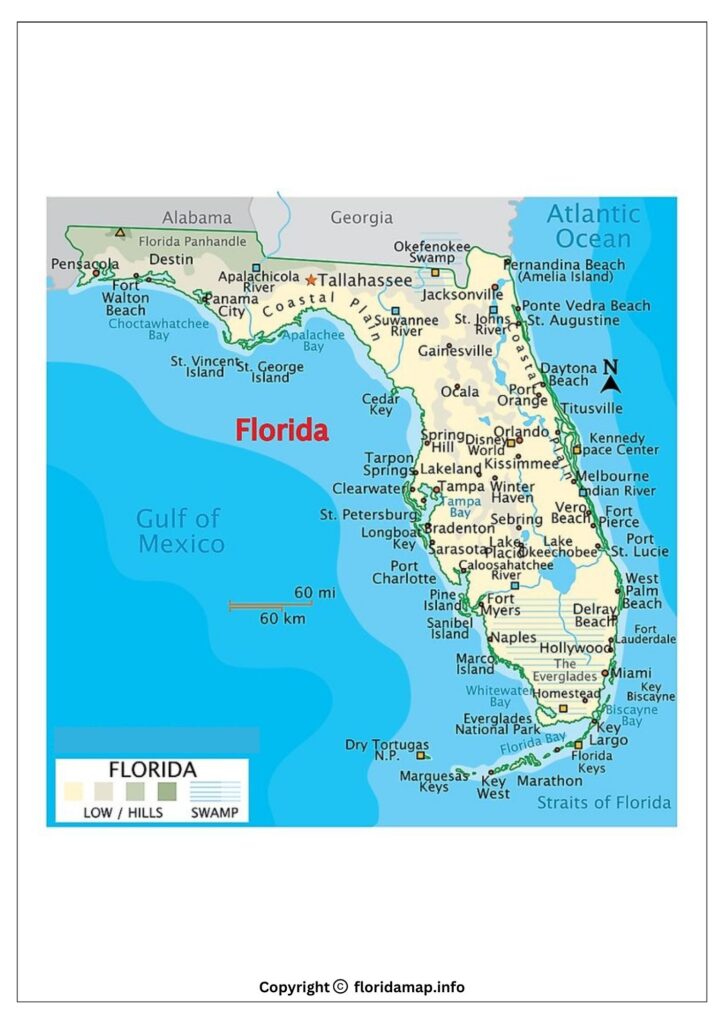Map of Florida beaches play a crucial role in various aspects, including tourism, recreation, environmental conservation, and emergency response. They serve as valuable tools for planning beach visits, identifying amenities and attractions, and navigating coastal areas safely.
Related Post –
Map of Florida Beaches
- Location and Access: Maps provide clear visual representations of beach locations, allowing visitors to identify specific beaches and plan their routes accordingly. They also indicate beach access points, parking facilities, and public transportation options, facilitating easy navigation to the desired beach destination.
- Beach Characteristics: Maps often include information about beach characteristics, such as sand type, water conditions, and wave intensity. This information can help visitors choose beaches that suit their preferences and safety considerations.
- Amenities and Attractions: Maps can identify the presence of amenities and attractions at specific beaches, such as lifeguard stations, restrooms, picnic areas, playgrounds, and concession stands. This information helps visitors plan their beach activities and pack accordingly.
Map of Beaches in Florida

Florida boasts a vast coastline with numerous beautiful beaches, each offering a unique experience. Here’s a list of some popular beaches in Florida:
- South Beach, Miami: Known for its lively atmosphere, art deco architecture, and vibrant nightlife.
- Clearwater Beach: Famous for its soft, white sand and family-friendly atmosphere on the Gulf Coast.
- Siesta Key Beach, Sarasota: Recognized for its powdery quartz sand and crystal-clear waters.
- Daytona Beach: Renowned for its hard-packed sand, making it popular for beach driving and various water sports.
- Fort Lauderdale Beach: A picturesque beach known for its boating canals, upscale resorts, and water activities.
- Naples Beach: Offers a serene and upscale coastal experience with fine white sand.
- Panama City Beach: Known for its emerald-green waters, sugar-white sand, and vibrant beach scene.
- St. Pete Beach: A family-friendly beach with soft sand and clear Gulf waters.
- Cocoa Beach: Famous for its proximity to the Kennedy Space Center and its surfing culture.
- Palm Beach: An affluent area with pristine beaches, upscale shopping, and luxurious resorts.
- Anna Maria Island: A laid-back destination with beautiful beaches on the Gulf Coast.
- Amelia Island: Known for its charming historic district and wide, sandy beaches.
- Grayton Beach State Park: Part of the Emerald Coast, offering unspoiled natural beauty and a coastal dune lake.
- Captiva Island: A quiet and scenic barrier island with beautiful shell-filled beaches.
- Hollywood Beach: Known for its lively boardwalk, family-friendly atmosphere, and broad sandy shores.
- Juno Beach: A serene and less crowded beach with a fishing pier and sea turtle habitat.
- Delray Beach: Offers a vibrant downtown area along with pristine beaches and clear waters.
- Vero Beach: Known for its uncrowded beaches, cultural attractions, and natural beauty.
- Pensacola Beach: Features white sand and emerald-green waters, with the Gulf Islands National Seashore nearby.
- Bahia Honda State Park: Located in the Florida Keys, known for its beautiful beaches and snorkeling opportunities.
These are just a few examples, and Florida has many more stunning beaches along both the Atlantic Ocean and the Gulf of Mexico, providing a diverse range of coastal experiences.
Map of Florida Cities and Beaches
Recreational Activities: Maps can identify areas designated for specific recreational activities, such as swimming, surfing, snorkeling, fishing, and boating. This information helps visitors find suitable locations for their preferred activities and avoid potential conflicts with other users.
Environmental Protection: Florida Map of Beaches can highlight sensitive environmental areas, such as protected wildlife habitats, nesting grounds, and marine ecosystems. This information helps visitors minimize their impact on the environment and make informed decisions about their activities.
Conservation Efforts: Maps can be used to track and monitor conservation efforts, such as beach restoration projects, erosion control measures, and habitat protection initiatives. This information helps organizations and stakeholders assess the progress and effectiveness of conservation efforts.
Emergency Response:
- Hazard Identification: Maps can identify potential hazards along the coastline, such as rip currents, strong tides, and areas prone to flooding or erosion. This information helps visitors be aware of potential risks and take appropriate precautions.
- Evacuation Routes: Maps can clearly show evacuation routes and emergency shelters in case of natural disasters, such as hurricanes or tropical storms. This information can help ensure the safety of beachgoers and facilitate an organized evacuation process.
- Resource Allocation: Maps can be used to coordinate emergency response efforts, such as deploying lifeguards, search teams, and medical personnel. This information helps allocate resources effectively and ensure a timely response to emergencies.
| Beach Name | Address |
| Siesta Beach | Siesta Beach, Florida 34242, USA |
| Venice Beach | 101 The Esplanade S, Venice, FL 34285, USA |
| Cocoa Beach | N Atlantic Ave, Cocoa Beach, FL 32931, USA |
| Fort Lauderdale Beach | Florida A1A, Fort Lauderdale, FL 33304, USA |
| Bonita Beach | Bonita Springs, FL 34134, USA |
Florida is renowned for its stunning beaches, stretching over 1,200 miles along the Atlantic and Gulf coasts. These beaches offer a diverse array of experiences, from tranquil stretches of pristine sand to lively hubs of activity.
Iconic Beaches:
- Siesta Key Beach: Embraced by sparkling turquoise waters and renowned for its sugar-fine, snow-white sand, Siesta Key Beach is a paradise for sunbathers, swimmers, and shell collectors.
- South Beach: Miami Beach’s iconic South Beach pulsates with energy, showcasing Art Deco architecture, vibrant nightlife, and a world-famous promenade.
- Clearwater Beach: With its soft, powdery sand and crystal-clear waters, Clearwater Beach is a family-friendly haven, ideal for swimming, snorkeling, and dolphin-watching.
- Sanibel Island: Renowned for its abundance of seashells, Sanibel Island offers a tranquil retreat, where visitors can explore nature trails, kayak through mangroves, and discover a wealth of marine life.
- Naples Beach: Elegance and luxury define Naples Beach, where upscale resorts, pristine white sand, and calm waters provide a refined beach experience.
Diverse Coastal Experiences:
- Surfing and Water Sports: Florida’s waves cater to surfers of all levels, from beginner-friendly breaks to challenging swells for experienced riders. Kayak tours, paddleboarding, and kiteboarding are also popular activities.
- Fishing and Diving: Florida’s diverse marine ecosystem attracts anglers and divers alike. Deep-sea fishing expeditions target marlin, tuna, and grouper, while shallow reefs offer opportunities for snorkeling and scuba diving among vibrant coral reefs and colorful marine life.
- Wildlife Encounters: Florida’s beaches provide opportunities to encounter wildlife, from dolphins frolicking in the waves to manatees grazing in seagrass beds. Sea turtle nesting season offers a chance to witness these gentle creatures laying their eggs on the sand.
- Cultural Immersions: Florida’s beaches reflect its rich cultural tapestry. Historic fishing villages, traditional seafood shacks, and vibrant waterfront festivals showcase the state’s unique heritage.
- Natural Beauty and Serenity: Florida’s beaches offer a sense of escape and tranquility. Secluded coves, untouched stretches of coastline, and lush vegetation provide a haven for relaxation and connection with nature.
Whether seeking relaxation, adventure, or cultural immersion, Florida’s beaches offer an abundance of experiences to captivate visitors and create unforgettable memories.
In conclusion, maps of Florida beaches are essential tools that provide valuable information for tourism, recreation, environmental conservation, and emergency response. They play a critical role in enhancing the beach experience, promoting responsible use of coastal resources, and ensuring the safety of beachgoers.


